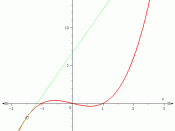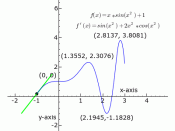Concepts of Calculus Calculus was invented independently by two mathematicians, Issac Newton of England and Gottfried Wilhelm Leibniz of Germany in the 1680s. Leibniz published his research in the journal ÃÂáÃÂÃÂ¥Acta EruditorumÃÂáÃÂæ in 1684 and Newton ÃÂáÃÂÃÂ¥s treatise was published in ÃÂáÃÂÃÂ¥Principia MathematicaÃÂáÃÂæ in 1687.
Calculus was mainly developed to solve two types of problems ÃÂáV the determination of tangents to curves, fig.1, and the calculation of area, fig. 2, especially for irregular shapes. Both of these problems are closely related to the rate of change of continuous function and the fundamental concept of calculus (also known as the ÃÂáÃÂÃÂ¥limitÃÂáÃÂæ). The following shows what limit is and what are its applications.
Fig.1 Given a function f(x) and a point P(x,y) on its graph, find an equation of the line tangent to the graph at P.
Fig.2 Given a function f(x), find the area between the graph of f(x) and an interval [a,b] on the axis.
In plane geometry, a line is called a ÃÂáÃÂçtangentÃÂáÃÂè to the circle if it meets the circle at precisely one point, fig.3a. However, this definition is not correct for all kinds of curves and irregular shapes. In fig.3b, the line meets the curve exactly once, yet it is not a tangent. Meanwhile in fig.3c, the line is a tangent, yet it meets the curve more than once.
Fig.3 For tangent that applies to curves other than circles as in fig.4a, point P on curve in the xy-plane and Q is any point on the curve different from P, the line through P and Q is the ÃÂáÃÂÃÂ¥secantÃÂáÃÂæ line (the secant line is a line that intercepts a curve at at least two points). If Q moves along the curve toward P, fig.4b., the secant line will rotate toward a ÃÂáÃÂÃÂ¥limitingÃÂáÃÂæ position. The line occupying this...


